Last year the hive on the scale didn’t do as well as most of them. We had an endless litany of problems with that colony. During the inspection in late March just as the maples were starting to bloom, I found queen cells, and it appears they raised a new queen far to early in the year. In mid April, that new queen was walking on the frames and laying some eggs, much to my surprise, there was worker brood present, so she did manage to get mated, altho not well mated, there was as much drone brood as worker brood in a fairly small colony at the time. We tried to ‘fix’ this colony by placing a ripe cell in there from the first round of grafts here. I marked the queen in the colony, then placed the cell. 3 weeks later when I looked, no sign of a marked queen, but there was an unmarked queen walking on the frames, and it finally looked like a decent brood pattern, I expected them to recover. A month later, yet again, ripe queen cells on a frame, no eggs, so once again they were requeening. Doubtful they swarmed, if they had, I would have seen it on the scale data, and I dont think they had enough bees to produce a viable swarm. I stopped trying to ‘fix’ the colony, and let them go thru another re-queen cycle on their own schedule.
By late August, the colony looked ok, and they were packing on some winter stores. In a year that had a very good flow, other colonies in the same yard filled top deep and two supers, this one did eventually fill one super, which we left on for winter stores. In October, disaster yet again for this colony, walked out to the bee yard one day to see it laying in pieces on the ground. Something had knocked it off the stand. Most of our colonies are strapped, but this one was not due to the problems of getting a strap around it that wont interfere with the scale setup. They were obviously not happy that morning, but I carefully stacked all the boxes back up, not much else you can do at that time of the year.
In February, when we opened hives for the first round of spring patties, the colony was alive, but, barely so. A small cluster of bees with a queen, lots of honey, no brood. The colony was maybe the size of a softball, which really isn’t a large enough cluster to kick of spring brood that early in the year. The colony next to them was in very good shape, 7 frames of bees on Feb 12. My real concern for the colony on the scale, they were to small to raise replacement brood, and likely unable to defend the entrance with honey in two boxes still. But, not a lot we can do to help them in February other than reduce the entrance and hop they make it.
Yesterday in the bee yard, we saw they had finally recieved the coup de grace. The large colony next door on the stand was busy robbing out the colony on the scale. I opened them up to check, as I suspected, a tiny cluster in the center, all dead, with a dead queen in the midst of them.
There is an old saying, to the winner goes the spoils. This afternoon I did some re-arranging in the bee yard, and now that colony that successfully robbed out the hive on the scale, is mounted above the scale. A few resets in a database, and now we are starting fresh with a new dataset for a new colony in 2018
So 2018 bee season is now underway. Our first round of feed is pretty much consumed, and the second round they have made a big dent in already. Most of the colonies that didn’t get hit by our 4 legged visitor last fall are looking good. An example.
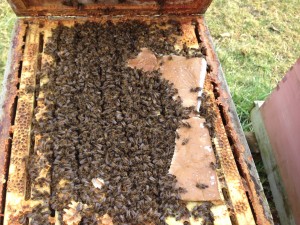
It looks like the patty is incorrectly placed beside the cluster. In reality, the first patty was directly over the cluster and the second round went on beside the first before it was finished. I took this photo just before I placed the third patty onto this colony.
We had an incursion by a 4 legged critter last fall.
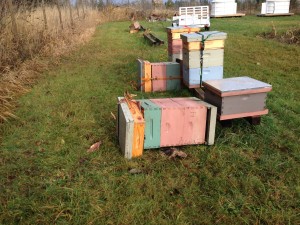
Not sure how long they were laying on the side like that, it happened while we were gone for some days. For those colonies that did get hit by our 4 legged visitor last fall, packages will be arriving this Saturday, March 3. I didn’t expect any to survive, total of 6 knocked over. 2 are still alive, 4 were dead by December.
Other events as we approach the new season, the bee truck has been upgraded. The Ford Ranger was a decent truck, but, I’m a tall person, and that short cab was problematic for my long legs. We now have a ‘new to us’ 2000 Toyota Tundra in the parking lot, ready to approach a season of moving bees.

When we bought this property in 2013, we set out a fairly extensive list of improvements to add over time. One of the larger items, and the last item on that list, was building a place to process honey and store bee equipment, we want to free up the garage for use as a garage.
Over the last two weeks, the project has been underway, and is now complete. The structure is 12×20 with a 4×12 section on one end carved out by an interior partition to be used as a warm room during the honey extraction process. The work area is 12×15 and will have the extractor permanently mounted, along with the bottling table and storage for all the relevant equipment. The building is finished, and over the next couple of weeks we will tackle the job of moving all the bee equipment from the garage into the honey house.

It was raining on Saturday, so we did spend most of the day on ‘inside work’, one of those tasks was to insulate the warm room (closet) in the honey house. The building is 2×4 framing, so we put fiberglass insulation between the studs, then stapled reflectex over that to contain the fiberglass and add another R3 of insulation value to the room as a whole. Based on how well the room heated up with two of us working in there after the fiberglass was in, and we were busy putting on the reflectex, it wont take much heat to keep it at a temperature suitable for storing honey boxes waiting on extraction.
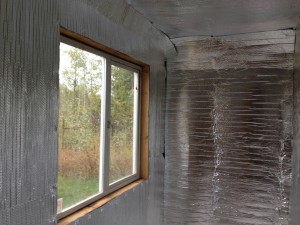
The whole build was sized around a ‘serious sideline’ bee endeavor. The warm room can hold 50 medium supers stacked 5 high, which means no lifting of heavy supers up over shoulder height. With the Mann Lake 9/18 extractor, 50 supers is 25 loads in the extractor, so roughly 5 to 6 hours of extracting. A honey pull from 25 hives with 2 supers on each turns into a weekend project, extract on Saturday and we can bottle on Sunday, with an expected yield of between 1000 and 1500 pounds of honey in bottles after weekend of processing. We usually have two of us working when extracting honey, but the setup in this facility will be laid out so it can be a one person job, uncapping the next load of frames while a load spins in the extractor. No more storing honey in 5 gallon buckets till we can get around to setting up for bottling, it’ll always be ready.
For winter storage, the warm closet has enough room to squeeze in 150 supers stacked floor to ceiling. This will be sufficient for us for the next few years.
The interior of the main work room is set up with the washtub, extractor permanently mounted, the bottling table set up under the window, and shelving for equipment storage on the other walls.
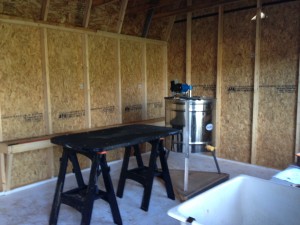
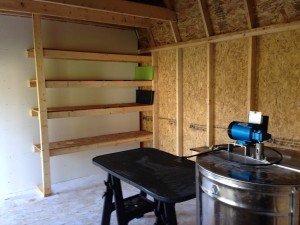
So it’s been an interesting season with regards to using a hive scale to monitor the bees this year. We haven’t learned much about the bees, but, we have learned a lot about snowloads. As it turns out, a scale hive is a fantastic way to understand the snowloads on your buildings. When we had the huge dump of snow in February, I was concerned about snowloads and trying to figure out if we needed to shovel some roofs. After some thought, I realized, the scale under the hive can answer that question quite handily. The telescoping cover is about 2.25 square feet, and it the scale showed a weight increase of just over 90lb thru that blizzard, so just under 40lb per square foot of snowload. This was well under the loads required by building code, so I relaxed with respect to shovelling the roof.
It’s Feb 26, records from prior years show we should be well into the spring bloom cycle. Well, maybe not this time, this morning there is another dump of snow sitting on the ground. It’s only about 10cm this time, but it’s a much heavier and wetter snow. The scale shows that there is roughly 11lb of snow sitting on top of the scale hive this morning.
I’m done with this now, I’ve had enough of winter, spring can come any time, we would be quite happy to be rid of this white stuff and see blooms starting, and I’m sure our bees feel the same way about it.
We had problems with the original broodminder unit set into the hive on the scale last fall, the issue was batteries going dead in a couple of days. The weather turned cold and I stopped trying to deal with that problem, we had reached the time of year where we dont want to open hives anymore, bees have the propolis seals in place for winter and I dont want to break those seals at that time of the year.
Earlier this week we had some nice weather, and on Monday we got out to do the first spring look at the bees. We popped the lids off of all of them, put on the first round of spring supplements, and while we had the lid off of the scale hive, I replaced the temperature and humidity sensor. So far, the replacement seems to be working much better, battery levels are reporting consistently in range of 87%. By Thursday the snow had melted enough I could get the lawn tractor into the back lot, so we took the chance to do a round of oxalic acid vapor to try knock down the mite population before the spring brood starts in earnest.
When we fed the bees, the pollen supplement went directly over the cluster and the temperature sensor right beside the supplement. I watched the graphs for a couple days, and the data looks good this time around, consistent measurements. The Broodminder is set to take a reading hourly, and it is providing temperature updates every 58 minutes like clockwork. The data proved to be very interesting, with definite patterns. The sensor went in on Monday, and thu till Friday we can see that the internal hive temperature is slightly above outside temps, and goes up and down with the ambient temp. On Friday this changed. Through the day on Friday the internal temperature went from around 15c strait up to 30c, which is approaching brood incubation temperatures, and it did not take the big drop overnight like we see on previous nights.
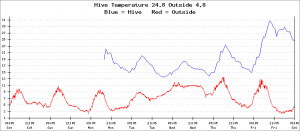
We normally see brood starting in early February, this winter has been much colder than years gone past, with hives buried in snow last week. But the internal temperature is fairly definitive this morning, the bees have started to incubate brood. The 2017 bee season has begun in Campbell River.
The question to ponder this morning. We put supplement on the bees on Monday, they have started to incubate brood by Friday. Is this a cause and effect relationship, or, is it just the normal time of year for them to start brooding ?
As an aside, the hive weight graphs are a bit skewed right now, but we did learn something interesting in the process. Last week the snow just dumped on us, it just kept on falling. At the peak, scale showed there was almost 80lb of snow sitting on top of a beehive. On the bright side, nature’s snowplow (rain) made it go away as fast as it came. There is a dramatic weight loss on the hive scale on Monday morning, that came about as we swept the remaining snow off the covers when lifting lids to check the bees. It was a nice warm day, the bees were flying, and we saw endless yellow spots on the snow as the bees got out to relieve themselves. That was a sure sign the bee season is about to begin, and the sudden increase in brood nest temperature is a confirmation, bee season has started.
2016 challenged the farm in so many ways. Poor fertility in the chicken breeding stock I had chose, signficant challenges with the bees, including a case of nosema that wiped out one of our early spring packages and weather issues that frustrated almost every attempt to plant our seed garlic meant that we continually planned and replanned our work.
2016 also showed us some amazing things. First, we achieved farm status for our lovely Rozehaven, something we had wanted since moving here. We are lucky our little plot is in the Agricultural Land Reserve so that aided us some. We credit our success with the variety of things we do on the farm to bring in revenue and support the revenue producing plans. Between garlic, Coucous de Malines chickens, and all products of the hive (honey, bees, etc) we are fairly diverse in our work. We also over-seeded our property with extra forage crops (mostly Dutch white clover) to ensure bee forage during dearth periods. Over all our plan has a variety meant to protect us against single crop/stock failure. 2016 proved that we also need to factor in total crop/stock failure potentials.
Garlic Fest in Merville in August 2016 was probably our single biggest AHA moment. The crowds were impressive and the collective growing potential of all the participating farmers was overwhelmed. We all realized that the market for fresh, local, and varied garlic is immense. At Rozehaven, we had planned to plant more seed to ensure we could meet some of the demand but early rains in August that seemlessly made way for snow in December meant that we could only plant in two of our prepared beds and likely will now keep all our garlic for seed in 2017. We shall see.
So 2017 is off with a bang, more snow, pretty heavy rains and lots and lots of planning on our parts. Maybe we are getting to be smarter farmers, but we now have multiple plans for the variety of things we have experienced. Only time will tell if they will be enough.
In the short term, we live in hope and have the support of the farmers and people of our communities to get us through. Here’s to 2017 — may it be a year of learning.
This has been the week of new toys around the farm. The week started with arrival of the shiny new JB700 oxalic acid blower, which should make the job of hitting the mites with Oxalic Acid Vapors a LOT faster. Using the older pan style vaporizer, it takes roughly 4 minutes per colony to do a round of oxalic treatments. After placing the pan into the hive entrance and blocking it, the unit has to be powered for a minute and a half to get up to temperature, then left in place for another minute to finish vaporizing. Add another minute and a half to take it out, reload, and prepare the next colony, works out to 4 minutes per hive.
With the new JB700, things change a bit, no, a lot. A single load of Oxalic in this vaporizer will do 4 hives, and it’ll do them in under 2 minutes. You fill the pan in the vaporizer with the OA, turn it on, and about 30 seconds later the acid starts to sublimate. Turn on the fan and stick the nozzle into the entrance of the first hive. When you see the vapor coming out of the cracks at the top, move on to the next one.
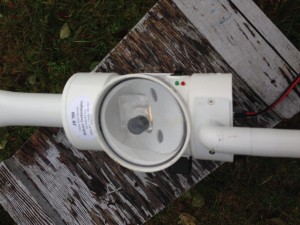
Wow. I took this shot 2 minutes after I vaporized the hives with the new JB700. If I had any doubt about enough OA in the colonies from a blast out of this thing, I dont anymore.
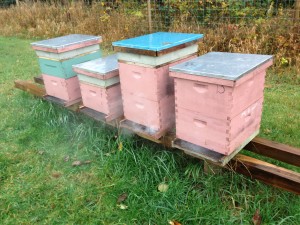
On my first outing, I did all of our colones (currently 18 of them) in 20 minutes, but half of that time was spent testing the new toy and getting to understand how it works. I ran one load of OA thru from start to finish with it just sitting on top of a hive to get a feel for how much vapor comes out of this gadget. This video shows the result. Do watch to the end when I walk around and take show the cloud of OA vapour drifting across the bee yard.
JB700 in action
If that wasn’t enough new toys for the week, this weekend another one showed up on Sunday afternoon.

I think this will certainly change how we do a lot of things around here. The small flat deck will be more useful than a regular pick up box and is very convenient for hauling bee hives around.
Varroa has been an ongoing issue for us over the years, but, in most years we have managed successfully, more by accident than by design. 2015 was the exception, and late in the season that year we had a number of hives experience the classic ‘varroa crash’ during August. This inspired me to learn a lot more about this pest in hopes of better managing it in the future.
In years gone past, I always tended to think of varroa populations in terms of bee brood cycles, and in my mind I roughly considered varroa to double over the 3 week interval which is a worker brood cycle. Reading and learning about this pest showed me that was a very serious mistake in understanding this pest. After reading many papers, and lot of online information, I digested it all into my own ‘simple’ form which is essentially a distilled version of everything I have read about this pest. During the bee brood season, the varroa life cycle runs two distinctly different phases, as the math below will show. Using averages which come from lots of different sources, the short form of the active life cycle boils down to a few basic numbers. A fertile varroa mite has an average life expectancy of 27 days during the summer season when bees are brooding. Like the bees, they live much longer when the colony is broodless and they are in ‘winter survival’ mode, but we will ignore that phase for this discussion, and focus on varroa populations during our active work bee season.
The female varroa mite will enter a cell shortly before it is capped, and does her reproductive magic under the capping with the developing bee brood. For a worker cell, the capped phase is 11 days, and during that time the female will produce one male offspring, and averages say something like 1.5 females. We all know that 1.5 offspring is not possible, so it really means some of them manage 1, and some of them manage to produce 2. For the sake of keeping our math simple, and estimating conservatively, we will just consider the case of 1 offspring produced. So in the typical cell, when the bee emerges, we will have 2 viable mites emerge from a worker cell, then spend approximately 4.5 days as phoretic mites before they once again enter a cell to reproduce. These numbers tell us, the reproduction cycle of the varroa mite runs at 15 days. Now follow thru what happens on the next round. Both of these fertile mites will once again reproduce and create one new fertile female each, to emerge with the developing worker bee. At the end of this cycle, we have 4 mites emerging, but, the original foundress mite is now reaching the end of her lifespan, and dies. So the net result is this, with one fertile mite at the start of the cycle, we go thru two full reproductive mite cycles which takes 30 days in total, and we end up with 3 viable mites in the colony. With only worker brood present, we expect the mite population to triple every 30 days.
The math changes when we have drone brood present, the mites will prefer the drone brood to reproduce if it’s present. So now follow the same cycle, but this time for drone brood. After spending the 4 days in phoretic phase of life, the female enters a drone cell which will be capped for 14 days. Literature suggests that the average offspring in drone brood with 14 days under capping will be something like 2.5, but again, we know you cant produce half a mite, so we will just look at the round numbers, assume she is producing 2 viable offspring. They emerge when the drone emerges 14 days later, and proceed to spend 4 days in the phoretic phase before entering cells to reproduce. On the second cycle we now have 3 viable mites entering cells, and all of them will produce 2 offspring, for a total of 9 mites emerging at the end of the cycle. One of those mites is the original foundress who has now reached end of life and dies, if she hasn’t already died in the cell. 14 days under the capping and 4 days phoretic gives us an 18 day reproduction cycle, and with one mite at the beginning of the cycle, after two cycles (36 days) we have 8 viable mites in the colony. An increase by a factor of 8 over 36 days is equivalent to doubling over 12 days.
Armed with this understanding of the mite reproduction cycle, lets look carefully at one bee season in the Comox Valley, or more specifically on our little farm here south of Campbell River. Our records show that we see hazelnut pollen typically around Feb 10, and checking on our bees shows that they are indeed starting a round of brood at that time, and have been every year we have been here, so, Feb 10 is the start of our season. Now lets follow the math for one colony that enters the season with one, and only one, viable mite ready to enter a brood cell on Feb 10.
In the early season, we have only worker brood, so the mite population will triple over a 30 day period. One mite on Feb 10 will result in 3 viable mites 30 days later, March 12. Another two mite breeding cycles takes us to April 10, and we now have 9 mites in the colony, but things are changing. On April 10 we will have drone brood available for the mites to breed in, so, instead of tripling over 30 days, we now reach the time of the season where mites can double every 12 days on average. By April 22 our 9 mites becomes 18, then May 4 we are up to 36. May 16 the number is 72, and reaches 144 by May 28. By 9th of June that number is up to 288, then 576 by June 21, the mid summer solstice. Assume we do a count of our mites at this time via a sugar roll or wash, bee population will be up near 50,000 bees, and there are just over 500 mites in the colony, our wash numbers say 1%, and everybody is happy, we are well below the ‘economic threshold’ for mites. or are we ??????
Continue now thru mite breeding cycles and watch the numbers. With 576 in the colony on June 21, that becomes 1152 mites by the July 1 weekend, we are now at 2% infestation on July 3. By July 15, that number doubles again, and we now have 2304 mites in the colony, and the number climbs to above 4500 by July 27, and north of 9000 by August 8 for an 18% mite load. At this point, things will start to deteriorate rapidly for a number of reasons. First off, we have a mite on 1 out of 5 bees, but since mites prefer to stick with the nurse bees in the brood nest area, it’s more like one on every second bee in the brood nest, so we will be getting very unhealthy brood at this point, most of which will have mites in the cells, and to really compound this problem, it’s a time of year when the bees are contracting the brood nest and starting to think about raising winter bees.
All I can say to this after working thru the numbers is WOW, now I understand why the ‘typical mite crash’ happens thru the month of August, mites left unchecked at that point are growing in numbers exponentially over 12 day periods. But armed with knowledge, now we can start to think about how to better address this problem. One thing I learned from two decades in aviation, accidents dont just happen, they usually come about from a chain of small things that add up to one big thing, and the key to aviation safety is break that chain early in the process. This is why we developed systems of checklists, so we dont end up in the situation where one small item forgotten early in the process cascades to the big event farther down the chain. We can take the same attitude to our bees and mites, and just look at the chain of events of population doubling over various periods.
If I home in on the timeframes where drone brood is present in the hive, what really stands out is this. One mite we eliminate today, is 8 mites we wont have in 36 days, which becomes 64 we wont have in 72 days, ie 10 weeks down the road. Expand this by one more cycle of 36 days, and it’s 512 mites we will not have 108 days (15 weeks) down the road. So now if I do some calendar math, we see hives crashing from mites in the early August timeframe. Every mite we remove from a colony on May 1 is potentially 500 mites we will not see on August 15.
Doing the math on mite life cycles was an enlightening experience for me, it fully explained some of the things I’ve seen in the field, and more importantly, shows me the importance of mite control early in the season. If I do a sugar roll to count mites in May and find one, and only one mite on 300 bees, the typical thought train is that load is light enough to ignore. On average roughly 20% of the mites are going to be phoretic at any time, the rest are hiding under cappings with brood, so my population at that time is indeed 5 mites per 300 bees, about 1.5% which is a number we have always been told to be under the ‘economic threshold’ for mites. But left totally unchecked, that population is more than enough to grow exponentially thru the season and kill the colony by August. A sugar roll or wash count of 2 mites on May 1 left unchecked results in a dead hive in August.
The other really important detail I took from this exercise is looking at the phoretic phase, and the phase of mites in the cells under cappings. If we do an intervention that only gets phoretic mites today, after measuring a population of 1% with drones brood in the hive, then come back 12 days later and check again, the colony will look like we didn’t do anything, and measure roughly 2% infestation. An intervention that only gets phoretic mites will NOT show up in counts until _at least_ 18 days later, when the mite brood that would have been from those mites would start to emerge. In the meantime, all of those mites that were hiding under cappings will continue to emerge over that period. Reality is, if I do an intervention on July 1 of a type that only affects phoretic mites, by July 5 I would expect to see a 25% increase in the population when I check due to all the mites that emerged in the 5 days between intervention and testing. If I do a single intervention on July 1 that effectively eliminates phoretic mites, I dont expect to see a decline in numbers before July 20, and in the intervening 3 weeks, the numbers will continue to skyrocket upwards, so much so that by July 20 the effect will hardly be noticeable anyways. If all the mites were specific and jumping into cells exactly 4 days after emerging, we would see the noticeable difference around July 20, but, the 4.5 days phoretic is only and average, so by 20 days down the road the decrease will disappear in the averages.
There is lots of food for thought to ponder in all of this, but, this exercise of doing some simple math on the mite reproduction schedule has been enlightening for me, and has me seriously re-thinking mite strategies. My biggest takeaway from it all is, low counts early in the season are a leading indicator for hives crashing in August, not an indicator telling me ‘good enough’.
Every spring at the bee club meetings the question asked by new beekeepers is ‘When is the swarm season?’. One answer given regularly by some of the old timers is this.
Swarm season begins when you see the first blossom on the apple trees, and is over when you eat the first raspberry.
It sounds like a reasonable answer, so we took note of a post from the Ocean Grove raspberry farm the day before yesterday, it mentioned eating the first ripe raspberry. The first thought is, yay, swarm season is over. Well, like always, the bees dont read that book, and sure enough, the very next day at 4:30pm the phone rings. There is a swarm of honeybees in town in a tree hanging over a well traveled sidewalk. So drop everything and off we go to collect a swarm of bees that has landed in a very inconvenient spot for one local business.
The bees were polite enough in this case to cluster on a branch only 8 feet off the ground, easily reached with the hose on the bee vac. I vacuumed them into the swarm collection box and brought them home. When they first went into the new box to be the new home, it didn’t look like they wanted to stay, and a fairly large cluster was starting to form on the outside of the box, so I added a frame of open brood from another hive. After about 15 minutes they had moved inside. Later in the evening, I wanted to confirm the swarm had a queen so opened it up again and started looking over the frames hunting for a queen, expecting it to be a difficult one to find because she would be slimmed down for flight before the swarm. She would have been difficult to spot, except thw big blue dot on her thorax made it trivially simple to confirm there is a queen in there with the rest of the swarm.
So for folks looking at the scale data recently, you will notice the scale hive has been offline for a few days. It’s an artifact of using an off the shelf scale that requires it be started with no weight on to set a new zero point after it’s been turned off. We had a power outage that turned off the scale, and I was out of town for a few days, so didn’t get it reset until this weekend. I put a short term solution for this kind of problem in place over the weekend, the scale now has a small ups to provide power thru short term power outages.
This is my biggest gripe with using an off the shelf electronic scale, all of the ones I’ve looked at suffer from this issue. When first powered up, they want to set a zero point, so you need to offload the hive when powering up the scale which is a royal PITA at times. Once it’s up and running, reading zero, then you put the hive back down on the scale. The ups is a band-aid type solution, at least it means the scale wont reset over a short term power outage, but a proper solution would be a scale that can be powered up with the load already in place. I haven’t found this one yet, but, still searching.











